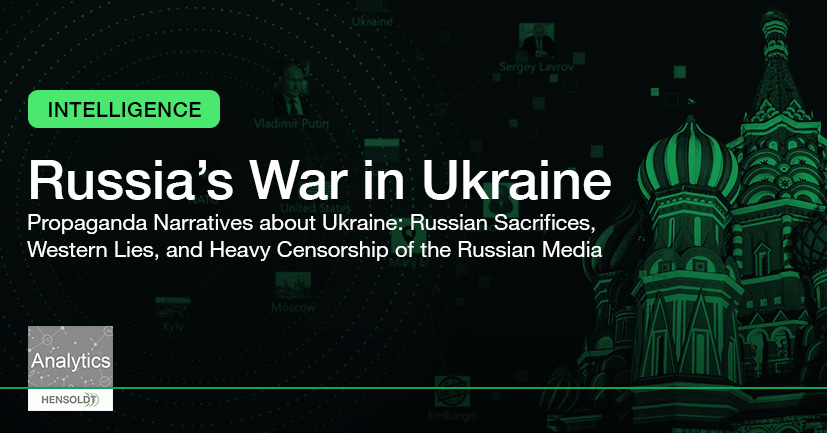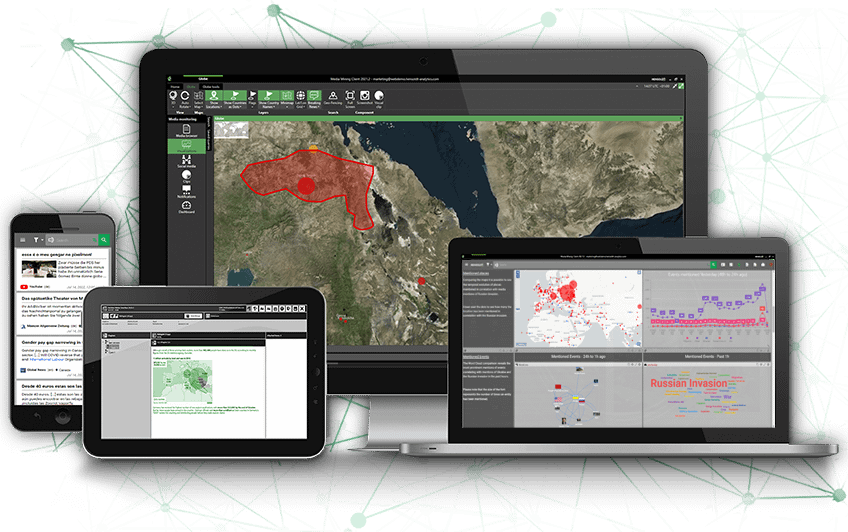Since the outbreak of Russia-Ukraine War in February 2022, intelligence agencies all over the world have been paying closer attention to propaganda managed by the Kremlin. What we have learned so far is that the Russian invasion on Ukraine has demonstrated a frightening new level of native propaganda that Russia can create.
In this article, we will look at some examples of Russian propaganda against Ukraine. While this propaganda was cultivated in Russia, it was also picked up by international media, including those owned by Russia’s allies.
Table of Contents
Russia’s Propaganda Ahead of the Invasion on Ukraine
Russia’s information campaign on kinetic conflict with Ukraine began locally in early 2021. From the initial days of the Russian military build-up near the Ukrainian border, Russia had actively claimed no intention of taking any military action against Ukraine. This wasn’t the first time Russia built troops along the border and can be seen as a continuation after the 2014 invasion of Crimea.1 Prominent Russian government officials claimed the build-up was “routine”.
Maria Zakharova’s December 2021 Statements
Russia has categorically denied engaging in “aggressive” politics with the wording being exclusively attributed to Ukraine and its allies, namely the United States. Maria Zakharova, the Director of the Information and Press Department of the Ministry of Foreign Affairs of the Russian Federation, had plenty to say in this regard in December 2021:
The (United) States is conducting a special operation to aggravate the situation around Ukraine while shifting the responsibility onto Russia. [Source: Kommersant]
This statement came after US media reports warned of a possible Russian attack on Ukraine. Zakharova is one of the key female figures in the Russian propaganda apparatus.
Minsk Agreements
A key foundation for examples of Russian propaganda relies heavily on the Minsk agreements. With the goal of ending conflict between Russia and Ukraine, the Minsk agreements have been cited by Russia in its propaganda against the Ukraine. This was particularly so in February 2022, as Putin recognised the independence and sovereignty of the Donetsk People’s Republic and the Lugansk People’s Republic. The goal by doing so was to destabilize Ukraine, and a few days later, Russia then invaded Ukraine on February 24, 2022.
Examples of Russian Propaganda Narratives
Narrative #1: Russia, the Betrayed Victim and Benevolent Hero
Used internally within the country, Russia often takes the role of saviour of its own people who have been betrayed. One of the most significant and telling moments of this narrative was the televised speech aired hours before the military action in the Donbass region. In a 56-minute-long address to Russians, Putin emphasized the long history between Russia and Ukraine. This was a second action following his article, ”On the Historical Unity of Russians and Ukrainians“, which was published on the July 12th. The article touched on past political decisions, which divided one nation into independent and malfunctioning entities.
In Putin’s own words, Russia remained cooperative, financially supportive, as well as united in the spirit of one country with, most notably, fellow Ukrainians.2 This being in contrast to post-communist states, which continue to struggle.
Russian politicians often refer to examples of Western disloyalties from the past in their communication to citizens.
Further examples of the Betrayed Victim and Benevolent Hero Narrative
Furthermore, Russian politicians often refer to examples of Western disloyalties from the past in their communication to citizens This is used to emphasize Russia’s aggressive responses against other countries. For example, the Izvestia newspaper published an article by the Russian Foreign Minister Sergey Lavrov, which contained a thorough analysis of a string of historical events meant to demonstrate campaigns against Russia orchestrated by the West. “There is a distinctive pattern that betrays the provocations staged by the West and its henchmen. In fact, they started long before the Ukrainian events,” reads the second paragraph of the “Staged Incidents as the Western Approach to Doing Politics” article.
Moreover, anti-West sentiments have been formalised in the revised Russian National Security Strategy published on the 3 July 2021. In a thorough analysis of the document, Julian Cooper at the NATO Defense College compared the new version of the decree with its previous 2015 edition. In his analysis, he pointed out several additions and changes of direction that highlight Russia’s worries of the increasing instability in the world. Some of the key elements of “safeguarding the people” (sberezhenie naroda) strategy rest on assuring “mutually advantageous international cooperation” and “the defence of traditional Russian spiritual-moral values, culture and historical memory”.
Narrative #2: Highlighting Kiev’s Incompetence and Talk Show Ridicule
Parallel to the messages of a large fascist population in Ukraine, Russian politicians target Ukrainian leadership as incompetent and corrupt. On October 11, 2021, Deputy Chairman of the Security Council of the Russian Federation Dmitry Medvedev published an article in Kommersant titled, “Why Contact with the Current Ukrainian Leadership is Meaningless: Five short Polemical Theses”.
On the day of the invasion on Ukraine, Putin addressed the nation and fostered the idea of Ukraine being governed by Nazis. Ultimately, Putin’s argued this required Russia to launch military action with the end goal of “denazifying Ukraine”.3
Parallel to the messages of a large fascist population in Ukraine, Russian politicians target Ukrainian leadership as incompetent and corrupt.
Talk Shows
Traditional media is one of best channels for discrediting Ukrainian government. This is because traditional media continues to reach the Russian population efficiently. Due to this efficiency, use of traditional media for propaganda has increased since the annexation of Crimea.
One of the popular propaganda vehicles are Russian talks shows. For example, Mesto Vstrechi (“Meeting Place”), hosted by Andrey Norkin, a known pro-Kremlin propagandist, is infamous for presenting particularly bold examples of disinformation. Mesto Vstrechi airs Monday through Friday evenings on state controlled NTV. Since the invasion of Ukraine, the discussions are primarily focused on criticising Ukraine and the West.
Another talk show, Vecher s Vladimirom Solov’yovym (“Evening with Vladimir Solovyov”) on Russia-1, has been diligently amplifying official propaganda. Vecher s Vladimirom Solov’yovym is hosted by a vocal supporter of Putin, Vladimir Solovyov.
Meanwhile, Vremya Pokazhet (“Time Will Show”) on Channel One Russia, a socio-political talk show, provides a platform for Putin and allied commentators to express their anti-West views. Conversely, while praising the Russian’s government decisions on the war with Ukraine.4 The show launched on the September 15, 2014, as Russia was suffering consequences of its action on Crimea. The subject of the first episode was sanctions against Russia and the response taken by Russia’s leadership.
Heavy Censorship of Russian Media
The entirety of Russia’s strategy of creating a convincing story amongst its citizens before launching the invasion on Ukraine relied on dominating native information sources. This was with scripted pro-invasion messages, as well as alternative storylines. Russian Roskomnadzor (RKN), the Federal Service for Supervision of Communications, Information Technology and Mass Media, is a direct descendant of various federal censorship departments existing in its current form since 2007. Before, two separate agencies controlled electronic and mass communications but were merged.5
While active in spreading messages aligned with Kremlin’s directives before the 2022 invasion, Roskomnadzor’s became a rapid-response tool immediately after the February 24th.
The entirety of Russia’s strategy of creating a convincing story amongst its citizens before launching the invasion on Ukraine relied on dominating native information sources. This was with scripted pro-invasion messages, as well as alternative storylines.
Roskomnadzor has been targeting independent TV, radio, and media channels, as well as social media platforms and online communication tools to fight the spread of “disinformation”.6 On February 26th, RKN issued a warning to independent media outlets forbidding the use of the word “war” in the context of Ukraine. Censorship as a method of propaganda continues targeting major newspapers through investigations. Most recently, a lawsuit was filed against the Novaya Gazeta to invalidate its license. According to Roskomsvoboda (Роскомсвобода), a Russian NGO that supports open self-regulatory networks and protection of digital rights of Internet users, Roskomnadzor blocked access to around 2300 websites between February 24th and April 17th 2022.
Alternative Storylines
It has been reported that the Russian population receives alternative versions of events compared to Western media’s coverage. According to Russia, the recent assassination of Darya Dugina has promptly been solved by Federal Security Service (FSB). By which, Russia has accused an Ukrainian secret service agent to be the alleged perpetrator.
In a recent BBC Live Blog entry, Vitaliy Shevchenko, Senior Monitoring Journalist at BBC Monitoring, reported that, “the underlying message of the Kremlin controlled coverage is that Ukraine is a terrorist state, with terms like ‘monstrous’ and ‘cynical’ are being used all the time.”
Conclusion
In conclusion, the internal propaganda campaign of the Russian government introduced and amplified a homogenous message across key governmental channels. At the same time, it limited free speech and independent journalism through a dedicated federal agency. On the international affairs front, every official speaking on behalf of the government maintains the same Kremlin narrative: the West is the true aggressor.
The effectiveness of the Russian disinformation campaign on its conflict with Ukraine is widespread with its citizens. This highlights Russia’s understanding of the importance of maintaining influence in the sphere of communication. The entire system, which has been carefully built over the years, can be characterised as effective and coordinated.
It is easy to understand why. Assuring the positive vote of the public is not only needed to neutralise opposition but also plays a crucial role in maintaining morale of Russian soldiers.





